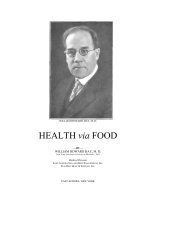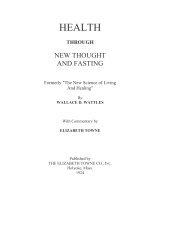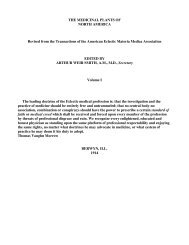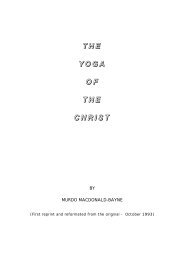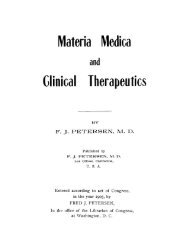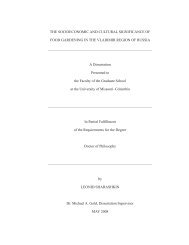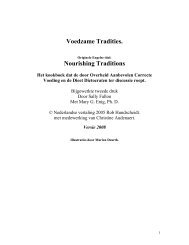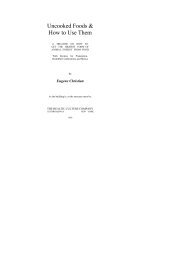FACTORS OF SOIL FORMATION - Midlands State University
FACTORS OF SOIL FORMATION - Midlands State University
FACTORS OF SOIL FORMATION - Midlands State University
You also want an ePaper? Increase the reach of your titles
YUMPU automatically turns print PDFs into web optimized ePapers that Google loves.
the composition of this parent material are expressed by differences in<br />
soil texture. For surface soils, we may write the following equation:<br />
Nitrogen = f (texture) cl, o, r, t, . . . (10)<br />
The constant soil-forming factors cl, o, r, and t are specified as<br />
follows:<br />
cl = climate of Iowa (approximately identical for entire series),<br />
o = prairie (now cultivated),<br />
r = gently undulating to rolling,<br />
t = unknown, but presumably the same for the entire series.<br />
In the foregoing equation it is assumed that the texture of the<br />
surface soil defines the parent material of the surface soil. Brown's<br />
comparisons are summarized in Table 10. Both nitrogen and carbon<br />
increase as the soils assume a heavier texture. The mean values for N<br />
and C are significant inasmuch as the variability within soil types is<br />
considerably less than between textural groups.<br />
Types of Parent Materials.—In Figs. 28, 29, and 30 are shown<br />
the distribution of various types of parent materials within the United<br />
<strong>State</strong>s. These maps were constructed from Marbut's "Distribution of<br />
TABLE 10.—THE AVERAGE NITROGEN AND CARBON CONTENT <strong>OF</strong> <strong>SOIL</strong><br />
TYPES <strong>OF</strong> DIFFERENT CLASSES <strong>OF</strong> THE CARRINGTON SERIES<br />
(Surface soils, 0 to 6 ⅔ in. depth)<br />
Nitrogen, Organic carbon,<br />
Texture of surface soils per cent per cent C/N<br />
Sand 0.028 0.40 14.1<br />
Fine sand 0.043 0.58 14.5<br />
Sandy loam 0.100 1.25 12.5<br />
Fine sandy loam 0.107 1.32 12.5<br />
Loam 0.188 2.21 12.2<br />
Silt loam 0.230 2.68 11.7<br />
parent materials of soils" in his Soils of the United <strong>State</strong>s in the Atlas<br />
of American Agriculture, Part III. According to Marbut,<br />
No attempt has been made to make it accurate in detail. In considerable<br />
areas, there may be some legitimate difference of opinion as to the source and<br />
character of the materials, such, for example, as on the plains of southern<br />
Idaho and parts of central Oregon and Washington. In central Texas, the<br />
western part of the area of residual accumulations from sandstones and shales<br />
contain areas of Great Plains materials and sands. The distribution of loess<br />
has been extended over areas about which there is no universal agreement.<br />
Notwithstanding these and many other areas of detail about which there is no<br />
universal agreement, the maps represent a mass of useful information.<br />
B. <strong>SOIL</strong> <strong>FORMATION</strong> ON IGNEOUS ROCKS<br />
Before the advent of the climatic theories of soil formation, parent<br />
material was considered the major soil-forming factor. In spite of a<br />
vast amount of work on the relationships between soil properties and<br />
underlying geological strata, relatively little information is at hand<br />
that can be interpreted in the light of functional analysis. As a rule, the<br />
correlations are suffering from lack of control of soil-forming factors,<br />
particularly climate.



